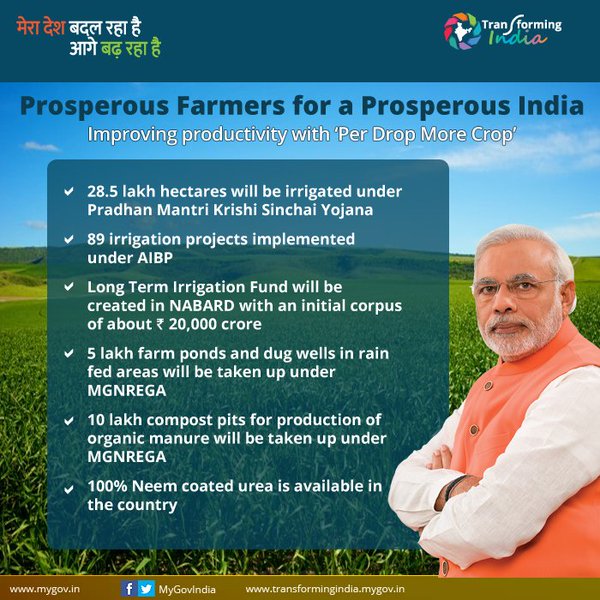Pradhan Mantri Krishi Sinchai Yojana (PMKSY): Have ever pondered yourself on a question “which sector in India is generating most employment?” Few may wonder to know that it is the agriculture sector that generates more employment opportunities by contributing to the country’s workforce by more than 50%. Agriculture is considered to be the backbone of Indian economy. People’s president APJ Abdul Kalam in his vision 2020 has given foremost importance to agrarian sector. But the empirical reports have revealed that more than 50% of the area where different crops are cultivated is deprived of sustainable and protective irrigation system leaving the farmers to depend on rainfall and other traditional means of irrigation. This could at times of low rainfall results in extreme droughts across the country.
With a view to provide permanent solution to this, government of India launched a scheme called “Pradhan Mantri Krishi Sinchai Yojana (PMKSY)”. As a part of this scheme, government will initiate various projects to create irrigation sources and sustainable & protected irrigation to the crops.
Content in this Article
Objectives of Pradhan Mantri Krishi Sinchai Yojana:
- The motto of this scheme is providing “Har Khet Ko Paani” and end-to-end solutions in irrigation supply chain, viz. water sources, distribution network and farm level applications.
- To achieve convergence of investments in irrigation at the farm level and the expand cultivable area under assured & protected irrigation
- To improve the on-farm water consumption efficiency to reduce wastage of water by adopting precision-irrigation and other water saving technologies such as drip irrigation, sprinkler installation etc.
- To implement sustainable water conservation practices by exploring the feasibility of reusing treated municipal & domestic waste water for peri-urban agriculture and attract greater private investment in precision irrigation system.
- To implement methods to recharge the ground waters through sustainable water conservation practices such as rain water conservation, construction of farm pond, water harvesting structures, small check dams and contour bunding etc.,
Components:
- Accelerated Irrigation Benefit Programme (AIBP):
This is to ensure faster completion of ongoing Major and Medium Irrigation projects that are implemented by Ministry of Water Resources, River Development & Ganga Rejuvenation
- Har Khet KoPani:
This is ensure to that every farm is given access to adequate irrigation by water source augmentation, distribution, ground water development, lift irrigation, diverting the water from water plenty to water scarce areas and supplementing rain water harvesting beyond Integrated water shed management program along with the renovation and rebuilding of traditional water bodies such as Jal Mandir (Gujarat); Khatri, Kuhl (H.P.); Zabo (Nagaland); Eri, Ooranis (T.N.); Dongs (Assam); Katas, Bandhas (Odisha and M.P.).
- Per drop more crop (Micro irrigation):
- This component focuses on yielding the maximum per a drop of water by reducing the wastage of water at field level by enhancing the water use efficiency.
- It mainly concentrates on micro level storage structures, efficient water conveyance & application, precision irrigation systems such as drips, sprinkler pivots, rain-guns in the farm;
- Secondary storage to store water when available in abundance (rainy season) or from perennial sources like streams for use during dry periods through effective on-farm water management
- water lifting devices like diesel/ electric/ solar pump sets including water carriage pipes, extension activities, coordination & management
- Watershed Development:
This focuses on drainage line treatment, soil and moisture conservation, water harvesting structure such as check dams, nala bund, farm ponds, tanks etc; ridge area treatment to improve the water storage capacities at ground level and water bodies
Integration with MGNREGS for creation of water source to full potential in identified backward rain fed blocks including renovation of traditional water bodies
Expected outcomes:
- Improved irrigation will bring more land under cultivation. Thus, contributes to more agricultural produce as the time progresses.
- High dependency on rain fall, nature can be curtailed to considerable extent making farmers secured of assured irrigation facilities.
- Farmers suicides can be lowered down
- Can see an increased transition of workforce from various sectors to agrarian sector as the condition improves
- Increased food security and low dependency on import of certain agricultural products that can be produced in domestic farms.
- Farmers will come up to invest and employ better technologies once the assurance is given with respect to irrigation.
It was said that an amount of Rs 50,000 crores will be spent over 5 years on this scheme. A program of such huge scale can be fruitful only when it is executed as promised to make the Indian farmers smile the tears.
Recommended

